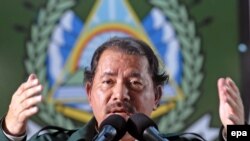The president of the Central American state of Nicaragua, Daniel Ortega, has followed Moscow's lead by recognizing the breakaway Georgian regions of South Ossetia and Abkhazia.
Nicaragua thereby becomes the first country to join Russia in officially recognizing the two regions. The move follows Russia's military incursion into Georgia in support of the separatists.
The aging Sandinista revolutionary, long a thorn in Washington's side, has broken ranks with the international community over the two Georgian regions at the center of a storm which has pitted Russia against the West in a replay of the Cold War.
Ortega is an old Cold War warrior himself, having been an ally of the Soviet Union and an unwavering critic of what he saw as U.S. imperialism in Latin America.
It's unclear what led him to recognize South Ossetia and Abkhazia, unless it is meant simply to tweak Washington's nose. He must know that the chances of those two regions gaining broad diplomatic acceptance in the foreseeable future is nil.
Even Latin America's hard-line leftist regimes, those of President Hugo Chavez in Venezuela and Raoul Castro in Cuba, have stopped short of recognizing the Georgian breakaways. They have contented themselves with expressing support for Russia.
Perhaps Ortega found life as a reinvented social democrat too dull after his years as a Marxist guerrilla leader.
Born into a middle-class family in the Nicaraguan city of La Libertad 65 years ago, Daniel Ortega was a leftist activist already by age 15. His leanings were confirmed when, as a law student, he joined the Sandinista National Liberation Front -- the organization which became, and remains, his political vehicle.
He participated prominently in the rebellion that in 1979 overthrew the dictator Anastasio Somoza. He later became a member of the ruling junta, and was elected Nicaraguan president in 1985.
But in the meantime, the United States had become incensed by what it saw as Ortega's efforts to spread Marxist revolution through Latin America. President Ronald Reagan's administration authorized the CIA to train and equip rebels who collectively became known as the contras.
The contras never managed to unseat Ortega through force, but he lost the 1990 presidential election and spent the next 15 years in political opposition, until his reelection as president in 2006.
Along the way he shed the trappings of Marxism, and restyled himself as a social democrat. But his decision to follow Moscow and recognize the Georgian breakaways seems an echo of a former era.
Nicaragua thereby becomes the first country to join Russia in officially recognizing the two regions. The move follows Russia's military incursion into Georgia in support of the separatists.
The aging Sandinista revolutionary, long a thorn in Washington's side, has broken ranks with the international community over the two Georgian regions at the center of a storm which has pitted Russia against the West in a replay of the Cold War.
Ortega is an old Cold War warrior himself, having been an ally of the Soviet Union and an unwavering critic of what he saw as U.S. imperialism in Latin America.
It's unclear what led him to recognize South Ossetia and Abkhazia, unless it is meant simply to tweak Washington's nose. He must know that the chances of those two regions gaining broad diplomatic acceptance in the foreseeable future is nil.
Even Latin America's hard-line leftist regimes, those of President Hugo Chavez in Venezuela and Raoul Castro in Cuba, have stopped short of recognizing the Georgian breakaways. They have contented themselves with expressing support for Russia.
Perhaps Ortega found life as a reinvented social democrat too dull after his years as a Marxist guerrilla leader.
Born into a middle-class family in the Nicaraguan city of La Libertad 65 years ago, Daniel Ortega was a leftist activist already by age 15. His leanings were confirmed when, as a law student, he joined the Sandinista National Liberation Front -- the organization which became, and remains, his political vehicle.
He participated prominently in the rebellion that in 1979 overthrew the dictator Anastasio Somoza. He later became a member of the ruling junta, and was elected Nicaraguan president in 1985.
But in the meantime, the United States had become incensed by what it saw as Ortega's efforts to spread Marxist revolution through Latin America. President Ronald Reagan's administration authorized the CIA to train and equip rebels who collectively became known as the contras.
The contras never managed to unseat Ortega through force, but he lost the 1990 presidential election and spent the next 15 years in political opposition, until his reelection as president in 2006.
Along the way he shed the trappings of Marxism, and restyled himself as a social democrat. But his decision to follow Moscow and recognize the Georgian breakaways seems an echo of a former era.











